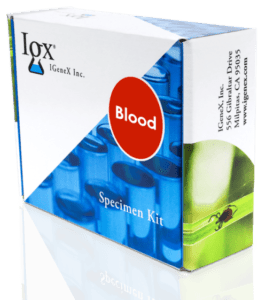• Indirect testing, and therefore useful when the pathogens are hiding, but eliciting an immune response.
• Active infection may be indicated when either IgM only, IgM and IgG, or IgG (≥ 160) antibodies are present.
• Specific for Bartonella hensalae.
Test
B. henselae IgM & IgG IFA
$160.00
The B. henselae Immunofluorescence Assay (IFA) is used to detect antibodies to B. henselae in human serum. Infections with B. henselae have been associated with Cat Scratch Disease, bacillary angiomatosis, peliosis hepatis, and bacteremia. Titers rise during the first two-to-four weeks of illness and decline over the next six-to-12 months. In patients with previously high titers, the presence of only IgG titer of less than 160 may indicate a resolving infection. If the IFA is negative but the clinical symptoms are present, PCR testing is suggested.
B. henselae is most often transmitted to humans by cats. Recently, it has been suggested that B. henselae can also be present in the same species of tick that transmits pathogens causing Lyme disease, Babesiosis, and Ehrlichiosis. Therefore, patients with positive titers should also be tested for the other tick-borne diseases.
Principle
The B. henselae IFA assay is a two-stage sandwich assay, based upon an antigen-antibody-complex formation involving the following steps:
- Binding of anti-henselae-specific antibodies in human serum to fixed B. henselae on a slide
- Binding of fluorescent-labeled anti-human IgG/IgM antibodies specific to the human anti B. henselae antibodies bound to fixed henselae on the slide
- Identifying green fluorescing henselae organisms with a fluorescent microscope
Tube / Specimen Requirements
1 SST/ minimum volume 0.5mL serum
CPT Code(s)
86317 x2
Sample Report
View
Early Disease, Late Disease
Test MethodologyIFA
Available in New YorkYes
IgM
< 20 Negative
20 May or may not indicate active infection.
≥ 40 Indicates active infection.
IgG
< 40 Negative
≥ 40 to < 160 May or may not suggest active infection. In patients with previously high titers, such titers may indicate resolving infection.
≥ 160 Indicates active infection.
- A negative IFA test result does not exclude the possibility of henselae infection.
- Results should be interpreted in conjunction with other laboratory and clinical findings.
Related Tests
GET STARTED TODAY!
The first step in getting tested with IGeneX is to order a collection kit. Choose between a Blood, Urine, or Miscellaneous kit.
WHY IGENEX FOR TICK-BORNE DISEASE TESTING?

- CLIA certified in all 50 states
- Long track record of success since 1991
- Offers testing that is nearly twice as accurate as CDC recommended tests
- Tests for all major tick-borne illnesses, including Lyme disease, TBRF, Babesia, Bartonella, and Rickettsia
- Utilizes comprehensive testing methods such as PCR, ImmunoBlots, IgXSpot and FISH
- Has become a nationwide leader in COVID-19 testing due to a relentless focus on customer satisfaction








